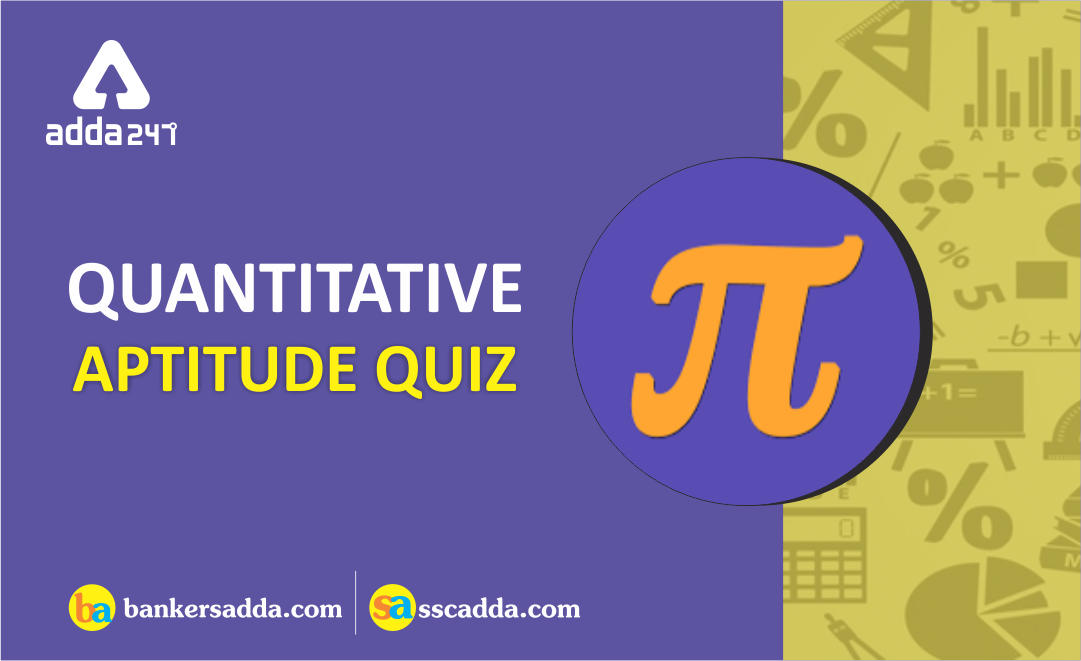Dear Aspirants,
Numerical Ability or Quantitative Aptitude Section has given heebie-jeebies to the aspirants when they appear for a banking examination. As the level of every other section is only getting complex and convoluted, there is no doubt that this section, too, makes your blood run cold. The questions asked in this section are calculative and very time-consuming. But once dealt with proper strategy, speed, and accuracy, this section can get you the maximum marks in the examination. Following is the Quantitative Aptitude quiz to help you practice with the best of latest pattern questions.
Directions (1-5): The following line graph shows the production (in lakhs) of bags of two companies VIP and SAFARI in five different years.
Study the graph and answer the following questions.
Q1. Find the average number of VIP bags over all the years
25 lakhs
20 lakhs
15 lakhs
27 lakhs
None of these
Solution:
Required average =1/5×(15+20+25+22.5+17.5) =20 lakhs
Q2. In which year production of VIP bags minimum than the bags of SAFARI?
2012
2013
2014
2010
2011
Solution:
From graph it is clear that the require year is 2012
Q3. By how percent production of VIP bags is more than the production of SAFARI bags in year 2014 ?
65%
80%
75%
70%
None of these
Solution:
Required percentage=(17.5-10)/10×100 =75%
Q4. What is the ratio of total production of SAFARI bags in years 2010, 2011 and 2013 together to the total production of VIP bags in the same years together ?
23 : 22
25 : 24
23 : 24
24 : 23
None of these
Solution:
Required ratio = (17.5 + 22.5 + 20) : (15 + 20 + 22.5)
= 60 : 57.5
= 24 : 23
Q5. What is the difference between total production of bags in two companies over all the years ? (in lakhs)
0
2
4
6
1
Solution:
Required difference = (17.5 + 22.5 + 30 + 20 + 10) – (15 + 20 + 25 + 22.5 + 17.5) = 0
Directions (6-10): In each of the following questions two equations are given. You have to solve the equations and
Q6. I. 3x² + 16x + 21 = 0
II. 6y² + 17y + 12 = 0
if x < y
if x ≤ y
relationship between x and y cannot be determined
if x ≥ y
if x > y
Solution:
I. 3x² + 16x + 21 = 0
⇒ 3x² + 9x + 7x + 21 = 0
⇒ (x + 3) (3x + 7) = 0
⇒ x = –3, –7/3
II. 6y² + 17y + 12 = 0
⇒ 6y² + 9y + 8y + 12 = 0
⇒ 3y (2y + 3) + 4 (2y + 3) = 0
⇒ y = – 3/2, –4/3
y > x
Q7. I. 16x² + 20x + 6 = 0
II. 10y² + 38y + 24 = 0
if x < y
if x ≤ y
relationship between x and y cannot be determined
if x ≥ y
if x > y
Solution:
I. 16x² + 20x + 6 = 0
⇒ 8x² + 10x + 3 = 0
⇒ 8x² + 4x + 6x + 3 = 0
⇒ (2x + 1) (4x + 3) = 0
⇒ x = –1/2, –3/4
II. 10y² + 38y + 24 = 0
⇒ 5y² + 19y + 12 = 0
⇒ 5y² + 15y + 4y + 12 = 0
⇒ (y + 3) (5y + 4) = 0 y
= –3, –4/5
x > y
Q8. I. 8x² + 6x = 5
II. 12y² – 22y + 8 = 0
if x < y
if x ≤ y
relationship between x and y cannot be determined
if x ≥ y
if x > y
Solution:
I. 8x² + 6x – 5 = 0
⇒ 8x² + 10x – 4x – 5 = 0
⇒ (4x + 5) (2x – 1) = 0
⇒ x = ½, –5/4
II. 12y² – 22y + 8 = 0
⇒ 6y² – 11y + 4 = 0
⇒ 6y² – 3y – 8y + 4 = 0
⇒ (2y – 1) (3y – 4) = 0
⇒ y = 1/2, 4/3
y ≥ x
Q9. I. 17x² + 48x = 9
II. 13y² = 32y – 12
if x < y
if x ≤ y
relationship between x and y cannot be determined
if x ≥ y
if x > y
Solution:
I. 17x² + 48x – 9 = 0
⇒ 17x² + 51x – 3x – 9 = 0
⇒ (x + 3) (17x – 3) = 0
⇒ x = 3/17, – 3
II. 13y² – 32y + 12 = 0
⇒ 13y² – 26y – 6y + 12 = 0
⇒ (y – 2) (13y – 6) = 0
⇒ y = 2, 6/13
y > x
Q10. I. 8x² + 26x + 15 = 0
II. 4y² + 24y + 35 = 0
if x < y
if x ≤ y
relationship between x and y cannot be determined
if x ≥ y
if x > y
Solution:
I. 8x² + 26x + 15 = 0
⇒ 8x² + 20x + 6x + 15 = 0
⇒ 4x (2x + 5) + 3(2x + 5) = 0
⇒ (2x + 5) (4x + 3) = 0
⇒ x = – 5/2, –3/4
II. 4y² + 24y + 35 = 0
⇒ 4y² + 10y + 14y + 35 = 0
⇒ 2y (2y + 5) + 7 (2y + 5) = 0
⇒ (2y + 5) (2y + 7) = 0
⇒ y = –5/2, –7/2
x ≥ y
Q11. Sohan spends 23% of an amount of money on an insurance policy, 33% on food, 19% on children’s education and 16% on recreation. He deposits the remaining amount of Rs. 504 in bank. How much total amount does he spend on food and insurance policy together?
Rs. 3200
Rs. 3126
Rs. 3136
Rs. 3080
Rs. 3800
Solution:
Remaining sum (in percentage)
=100 – (23+33+19+16)
= 9%
∵ 9% → 504
∴100%→504/9×100
→5600
∴ Required answer= ((33+23))/100×5600
=Rs. 3136
Q12. The base of a triangular field is three times of its altitude. If the cost of cultivating the field at Rs 50 per hectare be Rs 675, find its base and height. (1 hectare = 10000 m²)
900 m, 300 m
350 m, 850 m
750 m, 450 m
875 m, 325 m
None of these
Solution:
Area of the field
= (Total cost)/Rate=675/50
= 13.5 hectares
= (13.5 × (10000) m²
= 135000 m²
Let altitudes = x m
∴ base = 3x m
Now, ½ × 3x × x=135000
⇒ x² = 90000
⇒ x = 300 metres
& base 900 metres
Q13. The work done by a woman in 8 hours is equal to the work done by a man in 6 hours and by a boy in 12 hours. If working 6 hours per day 9 men can complete a work in 6 days, then in how many days can 12 men, 12 women and 12 boys together finished the same working 8 hours per day?
2½ days
1½ days
3½ days
4½ days
None of these
Solution:
Ratio of efficiencies of man, women and child
=1/6 :1/8 :1/12
= 4 : 3 : 2
∴ One day one hour work of all of them will be respectively
=1/(36×9), 3/(4×36×9) & 1/(2×36×9)
∴ One day work of (12M + 12W + 12B)
=(12×8)/(36×9)+(12×8×3)/(4×36×9)+(12×8)/(2×36×9)
=2/3
∴ Required days to complete the work
=3/2 days
=1½ days
Q14. Two trains start from the station A and B and travel towards each other at speeds of 50 kmph and 60 kmph respectively. At the time of their meeting the second train has traveled 100 km more than the first. The distance between A and B is
990 km
1200 km
1100 km
1440 km
1240Km
Solution:
Let first train travelled x km before meeting
∴ Second train will travel (x +100) km before meeting in same time as that by first.
(x+100)/60=x/50
⇒ x = 500 km
∴ Required distance = 2 × 500 + 100
= 1100 km
Q15. The areas of three consecutive faces of a cuboid are 12 cm², 20cm² and 15 cm², then the volume (in cm³) of the cuboid is
3600
100
80
60
120
Solution:
Let length, breadth and height of the cuboid be x, y and z.
Then, area of three consecutive faces, i.e.,
xy, yz and zx is 12, 20 and 15, respectively
∴ x² y² z²=12×20×15
xyz = √(12×20×15)=60 cm³




 Quantitative Aptitude Quiz For Bank Foun...
Quantitative Aptitude Quiz For Bank Foun...
 Quantitative Aptitude Quiz For SBI Clerk...
Quantitative Aptitude Quiz For SBI Clerk...



